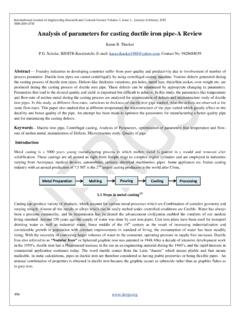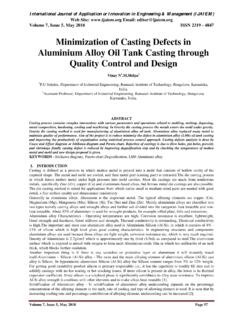Transcription of MINIMIZATION OF SURFACE DEFECTS ON BARS …
1 MINIMIZATION OF SURFACE DEFECTS ON BARS AND WIRE ROD originated IN billet casting (1) Cristian Genzano (2) Luis Pablo. Reda (2) Jorge Madias (3) ABSTRACT In order to minimise SURFACE DEFECTS in long products, their origin needs to be assessed. To this purpose, a methodology was developed, that includes metallographic studies on bar and wire rod using several reagents. A description is made of the different steps involved in this method, including the use of etchants to determine the former position of the defect in the billet , oxygen penetration, etc.
2 It is also discussed the interpretation given to internal oxidation, scale inside the defect, decarburisation, partial welding and other metallographic features. A discussion of pin holes and transverse cracks on billets is made, taking into account its aspect and metallographic features on the billet , the evolution during reheating and rolling and the final aspect and metallographic features on the bar/wire rod. Root causes for formation of these DEFECTS and solutions recommended are analysed for each case.
3 The paper is based on experience made by IAS Technical Centre while troubleshooting defect problems in carbon steel long products at South American steel plants. (1) To be presented in the XXXIV Semin rio de Fus o, Refino e Solidifica o dos Metais. 19 a 21 de maio de 2003 Belo Horizonte, Brasil. (2) Instituto Argentino de Siderurgia, Av. Central y Calle 19 Oeste, 2900 San Nicolas, Prov. de Buenos Aires, Argentina, (3) Technical Director.
4 Instituto Argentino de Siderurgia, Av. Central y Calle 19 Oeste, 2900 San Nicolas, Prov. de Buenos Aires, Argentina, 3861. INTRODUCTION casting of carbon steel billets for commercial products usually implies silicon and manganese deoxidation, and is mostly carried out with metering nozzle and oil lubrication. Under these conditions, SURFACE DEFECTS are often detected in the rolled products. So, finding the origin of DEFECTS in the as-rolled products is helpful in keeping control of casting conditions.
5 A methodology to reach this aim was developed at IAS along the time, as troubleshooting work for several plants was carried out. 2. METHODOLOGY TO DETERMINE THE ORIGIN OF DEFECTS The determination of the origin of DEFECTS includes the recording and analysis of general information. It is important to know the frequency of the defect, position in the same corner or face of the billet , position in the bar or wire rod (in one or some longitudinal lines), dependence on steel grade, etc.
6 It is also relevant an exhaustive study of the general appearance of the defect by naked eye or with magnifying glass. After that, the observation of polished samples, generally transverse cuts, of the rolled product or the billet , and the microscopic study at higher magnification, etching with different reagents, give insight into defect features. The information of the continuous casting and rolling processes is necessary and can give relevant data.
7 Some times it could be important to design the follow-up of heats in the meltshop or/and rolling mill process. This general criteria is summarised in table I. Tasks Information General information frequency, position, in one of the strands or in one of the faces of the billet , position in the bar or wire rod (in one or some longitudinal lines), influence of some steel grades, etc. Microscopic study with naked eye or helped with magnifying glass; polished samples observation, in general transverse cuts from rolled products, and etching with different reagents.
8 Process information routine data from the meltshop or rolling mill Own background and public literature search for similar DEFECTS in own reports and from other plants Heats follow-up in the meltshop and the rolling mill Physical or mathematical simulation generally it has only academic interest or for preventing the problem from repetition in the future Table I. Methodology for determination of the origin of DEFECTS . 3873. METALLOGRAPHICAL OBSERVATION The metallographic observation of polished samples gives key information when the origin of a defect needs to be determined.
9 Often, it is not possible to find out the origin of a defect with just the observation of a transverse cut in the light microscope, without an idea of the general aspect of the defect. In table II different techniques for the study of DEFECTS , and information that can be taken from them, regarding to the origin of DEFECTS are mentioned. These techniques, and the information that can be extracted by using them, have been discussed in detail in a previous paper [1].
10 Observation type Information obtained With naked eye or with magnifying glass Morphology, position, frequency As polished Position, penetration, direction, internal oxidation, partial welding, scale, inclusions, strange material Nital etching Decarburisation, banded structure, grain growth, segregation, transformation structures, material flow lines Oberhoffer s etching Segregation, solidification structure, location of billet corner, midway cracks, deformation flow pattern Alkaline sodic chromate etching Oxygen penetration B chet Beaujard s etching Hook formation, solidification structure SEM observation and EDS analysis Doubts about scale, macroinclusions origin, strange materials.











